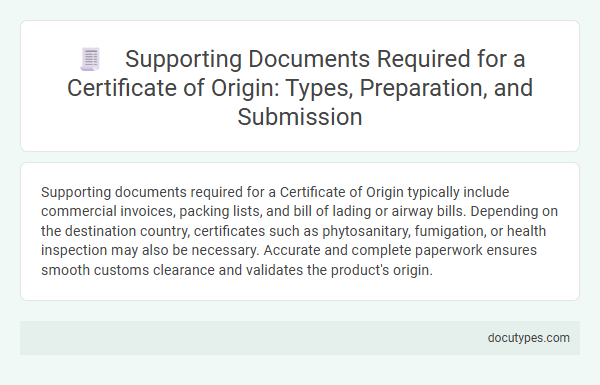Supporting documents required for a Certificate of Origin typically include commercial invoices, packing lists, and bill of lading or airway bills. Depending on the destination country, certificates such as phytosanitary, fumigation, or health inspection may also be necessary. Accurate and complete paperwork ensures smooth customs clearance and validates the product's origin.
Introduction to Certificate of Origin
The Certificate of Origin is a crucial trade document used to certify the country where the goods were manufactured or produced. It plays an important role in international trade by verifying the origin of goods.
- Commercial Invoice - This document details the transaction between the buyer and seller, including product descriptions and values.
- Packing List - Provides information on the packaging, quantity, and weight of the shipped goods to support the Certificate of Origin.
- Export Declaration - A government-issued document declaring the details of goods leaving the country, aiding in customs clearance.
Your supporting documents must accurately reflect the origin and nature of goods to ensure the Certificate of Origin is approved without delays.
Importance of Supporting Documents
Supporting documents are crucial for verifying the authenticity and details of a Certificate of Origin. Proper documentation ensures smooth customs clearance and compliance with international trade regulations.
- Proof of Manufacturing Location - This document confirms where the goods were produced, which is essential for origin verification.
- Commercial Invoice - It provides detailed information about the transaction, including product description, quantity, and value.
- Packing List - This lists the contents of the shipment, ensuring accuracy during inspection and delivery.
Types of Certificates of Origin
| Type of Certificate of Origin | Description | Supporting Documents Required |
|---|---|---|
| Non-Preferential Certificate of Origin | Certifies the country in which the goods were manufactured without preferences or reductions in tariffs. |
|
| Preferential Certificate of Origin | Used to claim reduced tariffs or duty exemptions under trade agreements such as NAFTA, EU trade deals, or ASEAN agreements. |
|
| Electronic Certificate of Origin | Digital version of the certificate used for faster processing and verification in international trade. |
|
| Chamber of Commerce Certificate of Origin | Issued and authenticated by a Chamber of Commerce, widely accepted by customs authorities globally. |
|
| Self-Certification Certificate of Origin | Exporter certifies the origin of goods without third-party verification, often allowed under specific trade agreements. |
|
Commonly Required Supporting Documents
Commonly required supporting documents for a Certificate of Origin include a commercial invoice, packing list, and bill of lading. These documents verify the shipment details and help confirm the origin of the goods.
Other frequently requested papers are export licenses, purchase orders, and certificates of manufacture. Your accurate documentation ensures a smooth processing of the Certificate of Origin by customs authorities.
Document Preparation Guidelines
Preparing the supporting documents for a Certificate of Origin requires careful attention to detail to ensure accuracy and compliance. You must gather commercial invoices, packing lists, and shipping documents that clearly specify the origin of the goods. Follow the guidelines provided by the issuing authority to avoid delays or rejections in the certification process.
Document Authentication and Legalization
Supporting documents for a Certificate of Origin primarily include invoices, packing lists, and shipping documents. Proper authentication and legalization of these documents ensure their validity across international borders.
Document authentication involves certifying the authenticity of signatures and seals on the supporting documents by relevant authorities. Legalization requires additional verification by consulates or embassies of the importing country to confirm compliance with local regulations. These steps prevent fraud and facilitate smooth customs clearance.
Electronic vs. Paper Submission Formats
Supporting documents for a Certificate of Origin typically include commercial invoices, packing lists, and shipping documents. Electronic submissions require scanned copies of these documents, adhering to specific format guidelines set by issuing authorities. Your choice between electronic and paper formats impacts processing speed and verification procedures.
Submission Process and Timelines
What supporting documents are needed for a Certificate of Origin?
The submission process requires accurate and complete documents such as commercial invoices, packing lists, and bills of lading to verify the origin of goods. Timelines for submission vary by issuing authority, typically ranging from a few days to two weeks to ensure timely processing of your certificate.
Common Challenges and Solutions
Supporting documents for a Certificate of Origin are crucial for verifying the product's origin and ensuring smooth customs clearance. Common challenges arise from incomplete or inaccurate paperwork, which can delay shipments and increase costs.
- Incomplete Commercial Invoices - Missing product details or incorrect values often cause verification issues during customs inspection.
- Discrepancies in Export Declarations - Variations between export declarations and supporting documents lead to certificate rejection.
- Lack of Manufacturer's Statement - Absence of this statement can prevent confirmation of product origin, complicating certification.
What Supporting Documents Are Needed for a Certificate of Origin? Infographic

